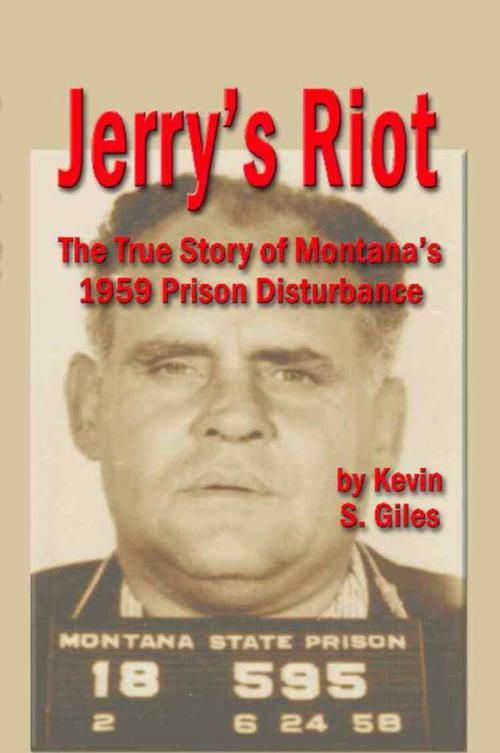JERRY'S RIOT: The True Story of Montana's 1959 Prison Disturbance
Nonfiction, Social & Cultural Studies, Social Science, Crimes & Criminals, Penology, Biography & Memoir| Author: | Kevin S. Giles | ISBN: | 9781621411659 |
| Publisher: | BookLocker.com, Inc. | Publication: | April 25, 2005 |
| Imprint: | Language: | English |
| Author: | Kevin S. Giles |
| ISBN: | 9781621411659 |
| Publisher: | BookLocker.com, Inc. |
| Publication: | April 25, 2005 |
| Imprint: | |
| Language: | English |
In Jerry’s Riot: The True Story of Montana’s 1959 Prison Disturbance, author Kevin S. Giles captures the conflict that ensued between Warden Floyd Powell and career criminal Jerry Myles, who had done time at Alcatraz Island and other federal and state prisons. Both men were new to Montana State Prison in Deer Lodge. Powell wanted to reform the prison. Myles wanted to run it.
That conflict came to a violent climax on April 16, 1959, when Myles and accomplices Lee Smart and George Alton seized rifles from the guard catwalks in both cellhouses.
"The cause of the riot is often wrongly portrayed as an escape attempt," Giles said. "That wasn’t the motive behind it. Jerry Myles didn’t want out of prison. He wanted glory. In his mind Powell and Deputy Warden Ted Rothe shamed him, and he was going to show them who was boss."
The riot made news from coast to coast. National magazines like LIFE and Saturday Evening Post sent correspondents to Deer Lodge. Inquiries even came from London.
"This is a story of men in crisis," Giles said of his book, which he spent 10 years researching and writing. "Despite all the news coverage of the riot over those three days in 1959, little was said or understood about the reasons for it. The riot tore apart many of the men involved and brought anguish to their families."
"Jerry’s Riot" recounts Myles’ childhood and his long prison history. It also examines the circumstances leading to the 1959 riot, including the 1957 “pea riot" disturbance at Montana State Prison. Giles writes about the 1959 riot, including the taking of 26 hostages, in careful detail.
Soon after Giles started investigating the riot in 1995, it became clear to him that Jerry Myles was the central figure of the story. "I didn’t have a title for the book for a few years until Jerry Myles emerged in the dominant way he did in my research," Giles said. "Here was a psychopath who had led a mutiny at the federal prison in Atlanta, and then had watched a fatal escape attempt at Alcatraz. It was like he was a riot leader in training. What he did to gain control of Montana State Prison was hauntingly similar to what he’d seen happen in Alcatraz."
Myles was in charge of the garment shop inside the walls when Powell came to Deer Lodge in the summer of 1958 from Wisconsin State Prison. Powell was the first Montana State Prison warden who was not a political appointee. A few months later, he hired Ted Rothe, an industries supervisor from the same prison in Wisconsin, to be his deputy warden.
Despite Powell’s determination to make the prison more secure, it fell like a house of cards on April 16, Giles said. "The riot succeeded because of rifles that guards carried on the catwalks in both cellhouses. Unfortunately, one of them had ammunition. Those rifles gave Jerry Myles great leverage to start his riot."
In Jerry’s Riot: The True Story of Montana’s 1959 Prison Disturbance, author Kevin S. Giles captures the conflict that ensued between Warden Floyd Powell and career criminal Jerry Myles, who had done time at Alcatraz Island and other federal and state prisons. Both men were new to Montana State Prison in Deer Lodge. Powell wanted to reform the prison. Myles wanted to run it.
That conflict came to a violent climax on April 16, 1959, when Myles and accomplices Lee Smart and George Alton seized rifles from the guard catwalks in both cellhouses.
"The cause of the riot is often wrongly portrayed as an escape attempt," Giles said. "That wasn’t the motive behind it. Jerry Myles didn’t want out of prison. He wanted glory. In his mind Powell and Deputy Warden Ted Rothe shamed him, and he was going to show them who was boss."
The riot made news from coast to coast. National magazines like LIFE and Saturday Evening Post sent correspondents to Deer Lodge. Inquiries even came from London.
"This is a story of men in crisis," Giles said of his book, which he spent 10 years researching and writing. "Despite all the news coverage of the riot over those three days in 1959, little was said or understood about the reasons for it. The riot tore apart many of the men involved and brought anguish to their families."
"Jerry’s Riot" recounts Myles’ childhood and his long prison history. It also examines the circumstances leading to the 1959 riot, including the 1957 “pea riot" disturbance at Montana State Prison. Giles writes about the 1959 riot, including the taking of 26 hostages, in careful detail.
Soon after Giles started investigating the riot in 1995, it became clear to him that Jerry Myles was the central figure of the story. "I didn’t have a title for the book for a few years until Jerry Myles emerged in the dominant way he did in my research," Giles said. "Here was a psychopath who had led a mutiny at the federal prison in Atlanta, and then had watched a fatal escape attempt at Alcatraz. It was like he was a riot leader in training. What he did to gain control of Montana State Prison was hauntingly similar to what he’d seen happen in Alcatraz."
Myles was in charge of the garment shop inside the walls when Powell came to Deer Lodge in the summer of 1958 from Wisconsin State Prison. Powell was the first Montana State Prison warden who was not a political appointee. A few months later, he hired Ted Rothe, an industries supervisor from the same prison in Wisconsin, to be his deputy warden.
Despite Powell’s determination to make the prison more secure, it fell like a house of cards on April 16, Giles said. "The riot succeeded because of rifles that guards carried on the catwalks in both cellhouses. Unfortunately, one of them had ammunition. Those rifles gave Jerry Myles great leverage to start his riot."















